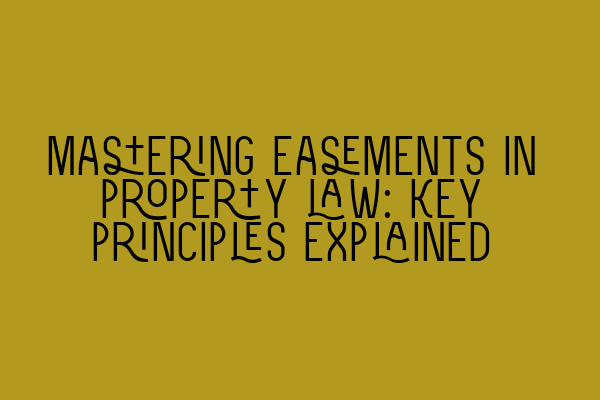Mastering Easements in Property Law: Key Principles Explained
As property owners, it is essential to have a solid understanding of easements and their implications. Easements play a crucial role in property law, allowing individuals to have specific rights over land that is owned by someone else. Whether you are a homeowner, a real estate investor, or a solicitor, grasping the key principles of easements is paramount to navigating property transactions and avoiding legal pitfalls.
In this comprehensive guide, we will delve into the world of easements, exploring their definition, types, creation, termination, and key principles, allowing you to master this fundamental aspect of property law. So, let’s get started!
What is an Easement?
An easement is a legal right to use or access someone else’s land for a specific purpose. It grants certain rights but does not transfer ownership of the land. Easements are typically granted by the landowner, known as the servient tenement, to the individual benefiting from the easement, called the dominant tenement.
Types of Easements:
1. Affirmative Easements: These easements give the holder the right to use the servient tenement’s land for a specific purpose, such as accessing a road or installing utility lines.
2. Negative Easements: These easements restrict or prohibit the servient tenement from doing something on their land that may interfere with the rights of the dominant tenement. For instance, a negative easement may prevent the servient tenement from building any structures that obstruct scenic views.
3. Appurtenant Easements: These easements exist alongside ownership of a particular property and benefit the property’s owner. They run with the land, meaning they are transferred to subsequent owners automatically.
4. Easements in Gross: These easements do not benefit a particular property; instead, they are tied to the individual or entity. For instance, a utility company may hold an easement in gross to access a property and maintain utility lines.
Creation of Easements:
Easements can be created in several ways:
1. Express Grant: The servient tenement grants the dominant tenement an easement through a written agreement or deed, clearly outlining the rights and restrictions.
2. Express Reservation: When someone sells their land but wishes to retain certain rights over it, they may reserve an easement for themselves.
3. Implication: Easements can be implied by the circumstances, based on the presumed intentions of both parties. For example, if two neighboring properties have a history of sharing a driveway, an easement by implication may be created.
4. Necessity: Easements by necessity are established when one landlocked property needs access to a public road. It ensures that the owner can access their property effectively.
Termination of Easements:
Easements can be terminated under specific circumstances:
1. Merger: If the dominant and servient tenements come under the ownership of the same person, the easement is terminated through merger.
2. Release: The dominant tenement can release the easement by signing a written document relinquishing their rights.
3. Abandonment: If the dominant tenement demonstrates a clear intent to abandon the easement and ceases using it, the easement may be terminated.
4. Prescription: If the servient tenement prevents the dominant tenement from using the easement for an extended period, the easement may be extinguished through adverse possession.
Key Principles of Easements:
1. Non-Dominant Party’s Responsibility: The servient tenement must bear any costs associated with maintaining and repairing the easement unless otherwise specified in the agreement.
2. Reasonable Use: The dominant tenement must exercise their rights over the easement reasonably and avoid causing unnecessary inconvenience or damage to the servient tenement.
3. Inalienability: Easements are attached to the land and cannot be separated from it. They pass on to subsequent owners automatically.
4. Exclusive Use: Unless stated otherwise in the agreement, the dominant tenement has the exclusive right to use the easement and prevent others from using it.
5. Duration: Easements can be created for a specific period or in perpetuity, depending on the agreement between the parties involved.
Mastering Easements in Property Law:
Understanding the principles of easements is essential for anyone involved in property law. Whether you are a solicitor advising clients, a homeowner dealing with neighboring property disputes, or a real estate investor, comprehending the nuances of easements will equip you with the knowledge necessary to navigate property transactions successfully.
By mastering easements, you can make informed decisions, negotiate effectively, and ensure your rights are protected. So, continue exploring the intricacies of easements, deepen your understanding, and unlock the full potential of property law.
